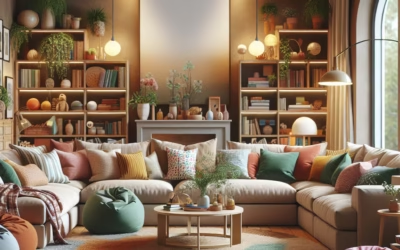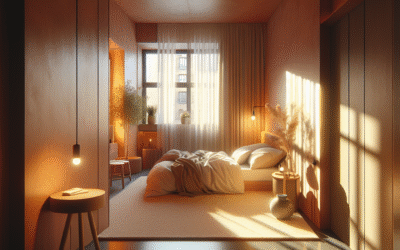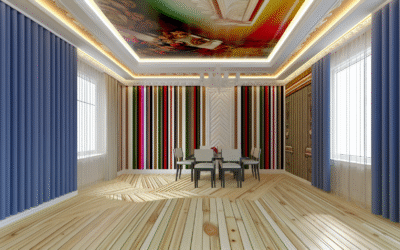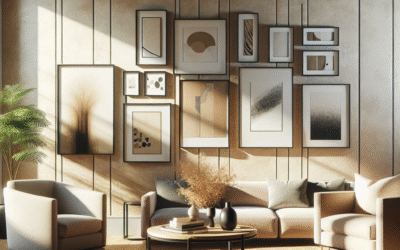
Transform Your Space: Chic Monochrome Bedroom Makeover Ideas That Elevate Style and Serenity
Have you ever walked into a room and felt an instant sense of calm? The secret often lies in the design, specifically in how color is used to establish ambiance. A monochrome color scheme — using varying shades of a single color — can transform your bedroom into a serene sanctuary. In this article, we will delve into chic monochrome bedroom makeover ideas that not only elevate your style but also your sense of serenity.
By the end of this comprehensive guide, you’ll learn practical tips to redesign your bedroom, understand the psychological effects of color, and develop a style that resonates with your personal aesthetic. We’ll cover:
- The psychology behind monochrome design
- Essential elements to a chic monochrome bedroom
- Step-by-step makeover ideas
- How to accessorize with monochrome
- Real-world examples and case studies
- FAQs about monochrome design
The Psychology of Monochrome Design
Monochrome design is more than just visually appealing; it has various psychological effects on the mind. Using shades of white, gray, black, or a single color can evoke feelings of calmness, focus, and harmony. For instance, soft blues can create a peaceful ambiance, while muted greens often inspire relaxation.
Key Psychological Benefits
- Reduced Stress: Simple shades can promote tranquility.
- Enhanced Focus: A clutter-free, monochrome environment helps prioritize tasks.
- Fostering Serenity: A cohesive color palette guides the eye and calms the mind.
Essential Elements of a Chic Monochrome Bedroom
Transforming your bedroom starts with understanding the essential elements of monochrome design. Here’s what you should consider.
Color Variations
Using various shades of your chosen color can add depth without overwhelming the senses. For example, using soft gray, charcoal, and black can create a stunning contrast while maintaining cohesion.
Textures
Incorporate various textures, from soft linens to sleek metallics, to add visual interest. This contrast between textures will keep the eye engaged while reinforcing the monochrome theme.
Lighting
Proper lighting is crucial. Use warm light sources to add warmth to your monochrome palette. Consider layered lighting options, combining overhead lights, floor lamps, and table lamps to create a balanced atmosphere.
Step-by-Step Makeover Ideas
Ready to dive in? Here are step-by-step makeover ideas to harness the power of monochrome in your bedroom.
Step 1: Choose Your Color
Pick one color that resonates with your personal style. Consider the mood you want to set in the space. Soft pastels promote relaxation, while bold hues can create a dynamic atmosphere.
Step 2: Select a Base Layer
Start with your bedding and curtains. Opt for fabric that feels good to touch and visually appeals. For a serene look, choose lighter shades as your base layer.
Step 3: Add Furniture
Incorporate furniture pieces that either match or contrast the base color. If your base layer is white, consider a dark wood nightstand for contrast.
Step 4: Incorporate Artwork
Artworks can serve as focal points. Look for pieces that incorporate your chosen color and add depth or interest to the design.
Step 5: Accessorize Wisely
Finish with carefully selected accessories — throw cushions, rugs, or lamps. Maintain a uniform color palette to solidify your design theme.
Accessorizing with Monochrome
Accessories play a crucial role in a monochrome design. Here are some practical tips to accessorize effectively.
Focal Points
Create focal points using larger accessories or artwork that draws attention without overwhelming. For instance, a large black-and-white photograph can serve as a dramatic backdrop.
Layering Textures
Mix textures — think soft wool throws or velvet cushions to add depth to the space while keeping to your chosen palette.
Lighting Fixtures
Opt for monochrome lighting fixtures. A sleek, black floor lamp can accentuate modern designs while adding utility.
Real-World Case Studies
For inspiration, let’s take a look at some real-world examples of chic monochrome bedrooms that have successfully utilized the strategies we’ve discussed.
Case Study 1: The Minimalist Sanctuary
In this project, the designer chose various shades of gray complemented by white accents. The result was a serene and sophisticated space that promoted relaxation.
Case Study 2: The Bold Monochrome
This case featured a dark-blue bedroom with variations in fabric and accent colors. It demonstrated how bold hues could create an energizing yet cozy atmosphere.
FAQs About Monochrome Design
What are the benefits of a monochrome design?
A monochrome design promotes harmony and tranquility, can simplify color choices, and provides a cohesive look to your space.
Can a monochrome scheme be used in small spaces?
Absolutely! Monochrome schemes can help create an illusion of space, making smaller rooms feel larger and more open.
How do I choose the right shade for my bedroom?
Consider the mood you want to create. Lighter colors evoke calmness, while darker tones can create intimacy and warmth.
What are the best accessories for a monochrome bedroom?
Textured pillows, throws, and monochrome art can add depth while maintaining the cohesive design theme.
Is monochrome design suitable for every bedroom style?
Yes! Monochrome can adapt to various styles, from minimalist to bohemian, by simply adjusting shades and textures.
Conclusion & Next Steps
In conclusion, a chic monochrome bedroom can significantly elevate your home’s style and enhance your sense of serenity. By understanding the elements of monochrome design, you can create a personal sanctuary that resonates with your aesthetic. Remember to choose your colors wisely, layer textures, and accessorize thoughtfully.
For more tips and inspiration, check out our related articles on interior design trends, color psychology, and bedroom layouts. Happy decorating!
Content Disclaimer
The information provided in this article is for educational purposes only and does not constitute professional design advice. For tailored guidance, consult a qualified interior designer.
Categories
- Accent Walls & Ceilings (61)
- Art Curation & Gallery (62)
- Bedding Style Trends (68)
- Bedroom Makeover (81)
- Bohemian & Eclectic Styles (58)
- DIY & Budget-Friendly Decor (64)
- Eco-Friendly Design (62)
- Furniture Care (71)
- Home Decor & Design Ideas (162)
- Home Wellness Spaces (59)
- Integrated Outdoor Living (67)
- Japandi Style (61)
- Kids and Nursery Decor (59)
- Living Room Decor (79)
- Mix & Match Techniques (73)
- Modern & Contemporary Design (66)
- Rug Sizing & Placement (73)
- Scandinavian Design Inspiration (20)
- Seasonal Home Decor (79)
- Small Space Solutions (73)
- Wall Art & Painting Tips (77)
Recent Comments
Archives
Product Gallery
-
Large Area Green Rugs for Bedroom Nordic Living Room Decoration Shaped Carpet Irregular Plush Lounge Rug Home Thick Washable Mat
Rated 5.00 out of 5$55.01 – $346.86Price range: $55.01 through $346.86 -
Nordic Style Rugs for Bedroom Morandi Living Room Decoration Carpet Large Area Geometry Lounge Rug Home Cloakroom Non-slip Mat
Rated 5.00 out of 5$39.51 – $598.43Price range: $39.51 through $598.43 -
Irregular Shapes Living Room Decoration Carpet Modern Style Rugs for Bedroom Home Thicken Plush Rug Fluffy Soft Lounge Floor Mat
Rated 4.83 out of 5$55.91 – $347.82Price range: $55.91 through $347.82














